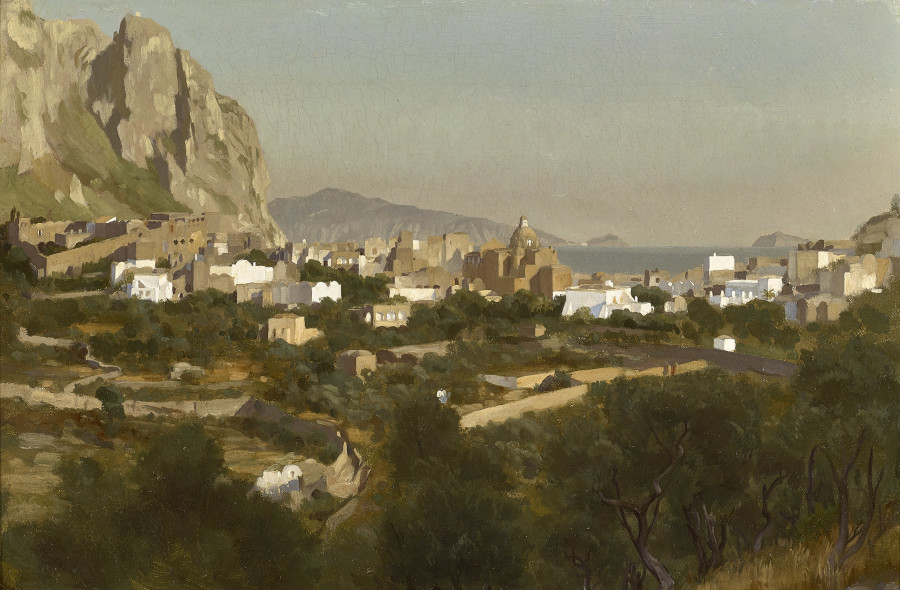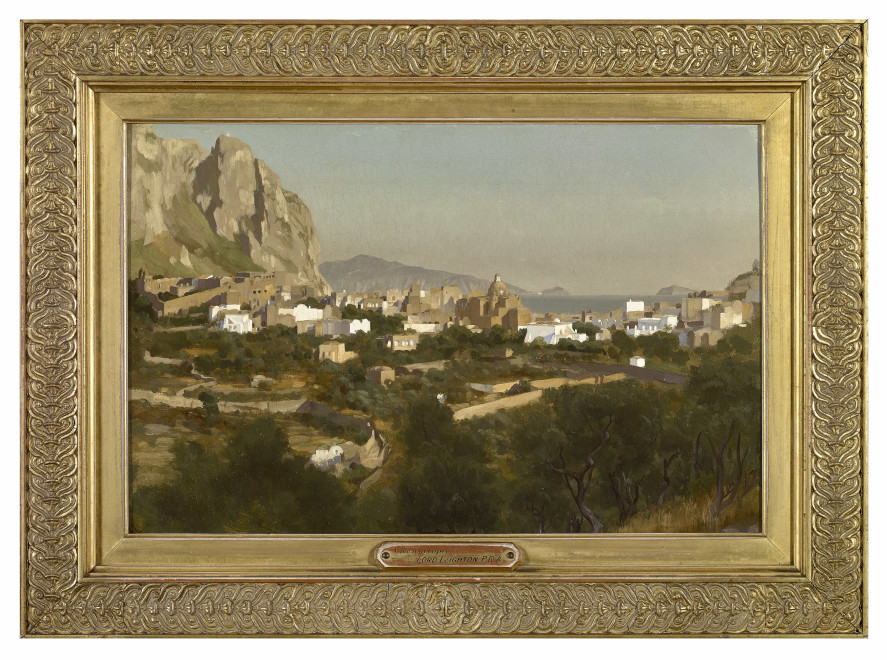27 by 41.3 cm.
In the summer of 1859, Leighton spent six weeks on Capri. This stay proved to be an incredibly fertile period and produced the artist’s first dated group of oil landscapes and probably his earliest surviving examples of plein air oil sketches.
Provenance
The artist.His studio sale; Christie's, London, 11-13 July 1896, lot 13, as A Town, Capri.
with Thomas Agnew & Sons, acquired at the above sale.
Sir Thomas David Gibson Carmichael, Bt. (1859-1926), Castle Craig, Peebleshire, acquired directly from the above, 11 July 1896.
His sale; Christie's, London, 10 May 1902, lot 29, as A Town in Capri.
with Leggatt Brothers, London, acquired at the above sale.
Private collection, UK, acquired circa 1925.
By descent to the present owner.
Exhibited
London, Royal Academy, Exhibition of works by the late Lord Leighton of Stretton, Winter 1897, no. 169, as The Town of Capri.London, Tate Britain, Pre-Raphaelite Vision: Truth to Nature, 12 February-3 May 2004, also Berlin, Altes Nationalgalerie, 12 June-19 September 2004, Madrid, Fundació 'la Caixa,' 6 October 2004-9 January 2005, pp. 211-212, 223, no. 131, illustrated.
London, Leighton House, A Victorian Master: Drawings by Frederic, Lord Leighton, 8 November 2006-25 February 2007, also Scarborough, Scarborough Art Gallery 24 March-3 June 2007, Bristol, Bristol Museum and Art Gallery, 22 June-2 September 2007, Bournemouth, The Russell-Cotes Art Gallery and Museum, 10 October 2007-6 January 2008, Glasgow, The Hunterian Museum and Art Gallery, 25 January-17 April 2008, pp. 39, 41, cat. ill. 5, unnumbered, illustrated.
Literature
L. and R. Ormond, Lord Leighton, Yale, 1975, p. 153, no. 60, as Town of Capri (catalogued as untraced).Catalogue note
In the decades before and after 1800, a golden age of painting outdoors (en plein air) emerged in Italy. Artists from France, Germany, Great Britain, and Scandinavia, all eager to paint from nature flocked to Italy, where conditions were ideal to experiment with the effects of changing light on their oil sketches—small, rapidly executed paintings usually made as preparatory studies for more ambitious compositions completed in the studio. Among the artists longing to paint the sun-drenched landscapes and monuments of Italy, was the young British artist Frederic Leighton. As expressed in his diary: “Italy rises before my mind… as a never-fading, gentle-beckoning image of loveliness; I am about again to tread the soil of that beloved country, the day-dream of long years is to become a reality” (Russell Barrington, The Life, Letters and Work of Frederic Leighton, New York, I, 1906, p. 62).
The style of the British painter is derived from a long tradition of landscape painting, classical in its origins as in the art of Claude and Poussin, but one which is also very modern. Leighton went beyond the mere replication of the form of landscape in the classical fashion, and sought freshness and immediacy to capture its very essence. In his oil sketches in particular, Leighton combined the principles of classical landscape --sketched landscape subjects were to become backgrounds and architectural details for figurative paintings-- with a more personal approach to nature and a poetic sense of color and light, such as introduced by the French school and Camille Corot especially.
In the summer of 1859, Leighton spent six weeks on Capri. This stay proved to be an incredibly fertile period and produced the artist’s first dated group of oil landscapes and probably his earliest surviving examples of plein air oil sketches. In this series, Leighton painstakingly recreated the various angles and aspects of the island at different times of day and under contrasting effects of light. He established the essential characteristics of his landscape art: rich, dense color is applied thickly to give a sense of the volume of buildings and to convey the textures of their materials.
Capri–Sunrise, painted from the pathway leading towards the south-eastern corner of the island and the Fariglioni Rocks, depicts the hazy glow of the early morning light. The pink and purples hues of the rising sun are still perceptible in the sky. In the middle ground stands the village of Capri, dominated by the church of San Stefano, surrounded by bright buildings made of the island’s distinctive white limestone. The effect is effortless and modern, and quite unlike anything Leighton’s fellow landscape painters were attempting.




